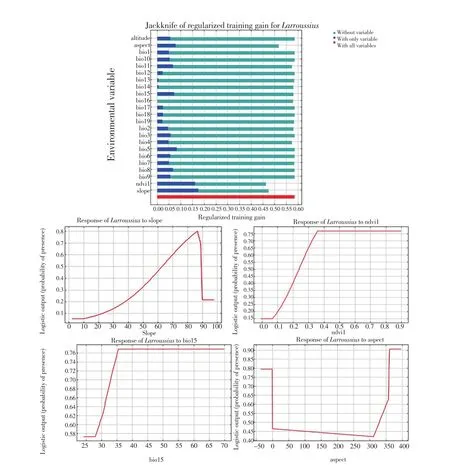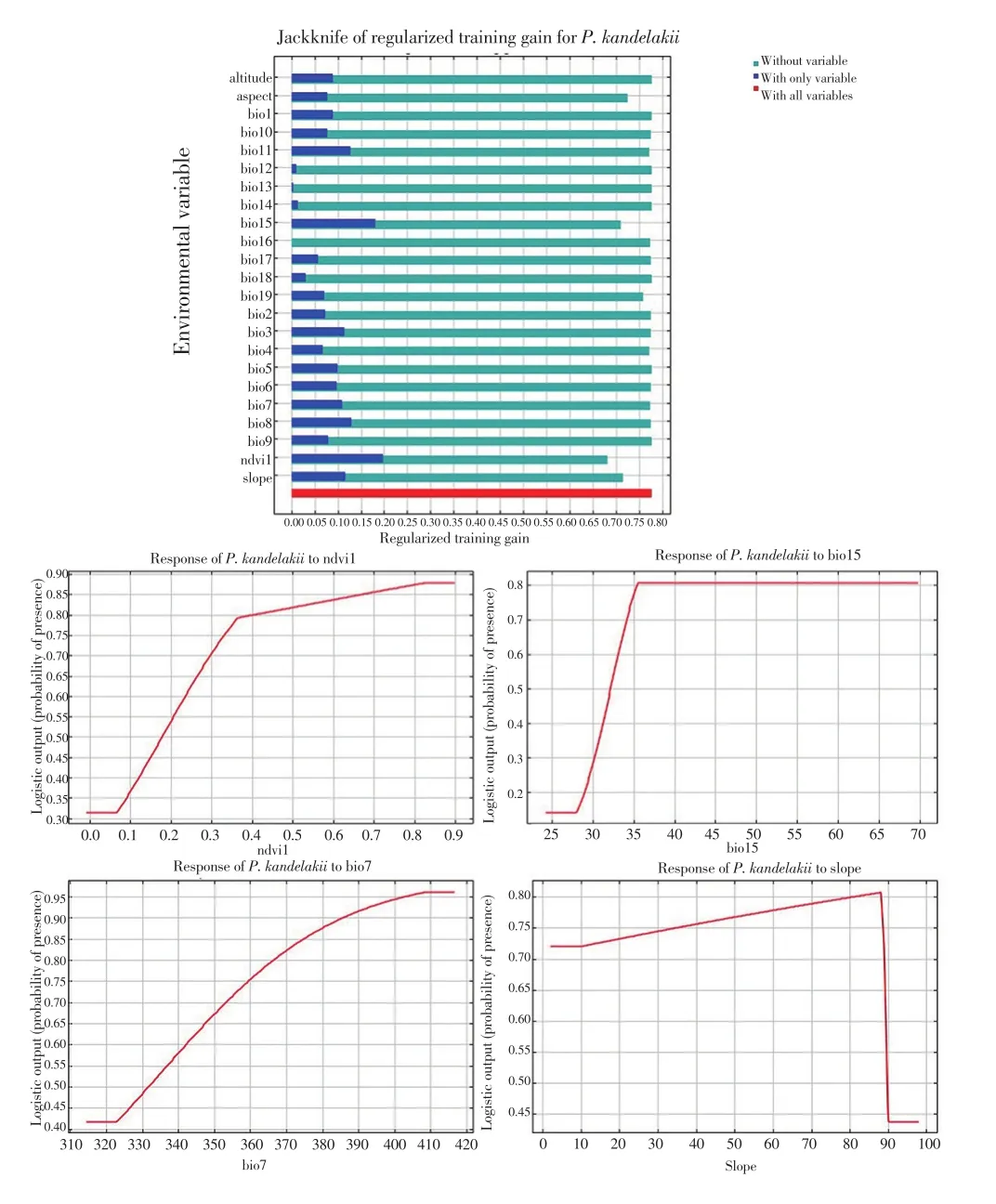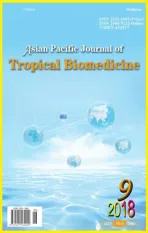Spatial distribution of sand flies (Diptera: Psychodidae; Larroussius group), the vectors of visceral leishmaniasis in Northwest of Iran
2018-10-12EslamMoradiAslYavarRassiDavoudAdhamAhmadAliHanafiBojdAbedinSaghafipourSayenaRafizadeh
Eslam Moradi-Asl, Yavar Rassi, Davoud Adham, Ahmad Ali Hanafi-Bojd, Abedin Saghafipour, Sayena Rafizadeh
1Department of Public Health, School of Public Health, Ardabil University of Medical Sciences, Ardabil, Iran
2Department of Medical Entomology and Vector Control, School of Public Health, Tehran University of Medical Sciences, Tehran, Iran
3Department of Public Health, Faculty of Health, Qom University of Medical Sciences, Qom, Iran
4Ministry of Health, National Institute for Medical Research Development, Tehran, Iran
Keywords:Larroussius subgenus Sand fly Ardabil Modeling Iran
ABSTRACT Objective: To determine spatial distribution of sand flies (Diptera: Psychodidae; Larroussius group), the vectors of visceral leishmaniasis in Ardabil province, Northwest of Iran. Methods:Sand flies were collected using sticky traps from the 30 selected points in Ardabil province,during May-November 2017. The MaxEnt model in GIS software was used for modeling.Results: A total of 2 794 specimens of sand flies were collected, of which 33% were Larroussius subgenus sand flies. Phlebotomus kandelakii and Phlebotomus wenyoni were the highest and lowest collected species respectively. Based on the modeling, four areas in the province were identified with more than 70% probability of the presence of Larroussius group vectors which were at risk of visceral leishmaniasis disease transmission. Conclusions: The distribution of Larroussius subgenus sand flies was observed in all parts of Ardabil. But the northern parts of the province (Germi and Bilesavar counties) as well as central part (Ardabil and Meshkinshahr counties) were of great importance in terms of the presence of Larroussius subgenus sand flies and the possibility of transmission of the visceral leishmaniasis.
1. Introduction
Leishmaniasis is a group of systemic diseases that are caused by parasites of the Leishmania complex subgenus and transmitted to humans and other mammals by sand flies bites[1,2]. The mortality rate of leishmaniasis is estimated about 51 600 cases in 2010 in the world[3] and it also causes 3.3 million disabilities per year[4].Leishmaniasis has been reported in 101 countries[5] and over 350 million people are living in at high-risk area of the world[6].Visceral leishmaniasis (VL) or kala-azar is a severe type of disease that occurs in different parts of the world. Some species of two subgenera of Phlebotomus and Lutzomyia are the main vectors of diseases in the Old World and New World respectively[7,8]. The annual mortality rate for VL disease is calculated 0.2-0.4 million[6].More than 90% of VL disease cases are reported from five countries of Brazil, India, Nepal, Bangladesh and Sudan[9]. In Iran, the disease is sporadically reported from different regions, but the endemic areas have been located in rural parts of the northwest, northeast and southern Iran[10-13]. Annually, 100-300 new cases of VL are reported from Iran, especially in Ardabil province[14] and more than 89% of affected cases were children under 5 years old of age[15]. So far, in Iran, 44 species of the sand flies have been reported and the presence of other 10 species was doubtful[16]. Among them, six species of sand flies in Larroussius group and Paraphlebotomus subgenera have been identified as the main or probable vectors in the transmission of VL in Iran[13,17-22]. Three species of them including Phlebotomus major (P. major), Phlebotomus keshishiani and Phlebotomus alexandri in southern Iran and the rest including Phlebotomus kandelakii (P.kandelakii), Phlebotomus perfiliewi (P. perfiliewi) and Phlebotomus tobbi (P. tobbi) in northwest and northeast of Iran (Ardabil province)are reported as the vectors of the disease. The main aim of this study was to determine the distribution of sand flies in subgenus Larroussius as the vectors of VL in different regions of Ardabil province in northwest of Iran and to model their probability of the presence in the province to establish a VL disease surveillance system.
2. Materials and methods
2.1. Study sites
Ardabil province is one of 31 provinces of Iran located on the northwest of the country with a longitude of 38.251 4 and latitude of 48.297 3. The population of province was 1 270 420 people in 2017.This province has 10 counties and has a cold region in the northwest of Plateau with an area of 17 952.5 Sq.km. It is part of the triangular Plateau of Iran in the east of Azerbaijan Plateau, about 2/3 of which has mountainous texture with high altitude and the rest is formed by the flat and low areas. The climate of Ardabil province is largely dependent on four factors of altitude, latitudes, water resources and Migratory Lows. Other factors such as vegetation, industrial and mining agricultural activities affect in small (Figure 1).
2.2. Sand flies collection
Sand flies were collected from 30 areas of 10 counties in the province during May-November 2017. The studied areas were identified and selected based on the prevalence of human cases of VL during the last 15 years. Six urban areas and twenty-four villages were selected and their geographic coordinates and altitude were recorded by GPS (Figure 1). Sand flies were collected using caster oiled papers (60 papers for indoors and outdoors of each area). They were installed before sunset and collected the following morning before sunrise. All collected sand flies were transferred to acetone and then stored in the 70% alcohol. All specimens were mounted a single drop of Puris’ medium and were identified using relevant identification keys[23,24].

Figure 1. Study area in Ardabil province, Iran 2017.
2.3. Data analysis
Excel and SPSS version 21 were used to analyze the collected data. Poisson’s regression analysis was conducted to investigate the relationship between sand fly frequency with average monthly temperature and relative humidity (P<0.05).
2.4. Modeling
The Maxent version 3.3.3 was used to predict the presence of subgenus Larroussius sand flies in order to prepare the distribution map at 52 locations (22 locations from previous published studies and 30 locations from the finding of present studies) in Ardabil province northwest of Iran[13,21,25-28]. Jackknife test was used to analyze the relationship between weather variables and distribution of sand flies and the relevant variables were identified with percentages and non-relevant variables were assigned zero. The output of the Maxent model was included in the ArcMap software and the probability of the presence of Larroussius subgenus members was divided to 5 categories of 0%-10%, 11%-30%, 31%-50%, 51%-70% and more than 70%. The output map of the ASCII format was converted into the raster format in the GIS software version 10.3.
3. Results
A total of 2 794 sand flies were collected and identified, of which 33.1% belonged to the Larroussius, 8.5% Adlerius, 20%Paraphlebotomus, 23.7% Phlebotomus, 0.2% Synphlebotomus and 14.5% Sergentomyia subgenera. From the Larroussius subgenus five species of P. kandelakii, P. perfiliewi transcaucasicus, P. tobbi, P.major and Phlebotomus wenyoni (P. wenyoni) were observed. The most frequency was related to P. kandelakii (39.3%) and the least frequency was related to P. wenyoni (0.4%) (Table 1). Considering sex, 72% of the sand flies were males and 28% of them were females. The sex ratio for the total of collected sand flies, the Larroussius sand flies and the P. kandelakii as the dominant species were calculated as 256.83, 258.14 and 185.82, respectively.

Table 1 Sand flies (Larroussius subgenus) fauna in the studied area, Northwest of Iran,2017.
Two main vectors of P. perfiliewi transcaucasicus and P. kandelakii(Larroussius group species) were collected from 93% and 82% of the studied areas. The monthly activity of the Larroussius sand flies is started from end of May and is finished in late November with one peak in July (Figure 2).
The results showed that 43% of the sand flies were collected from indoor and the rest from outdoor sites. The highest number of sand flies (15%) was collected from the stables (indoors) and the yards(24.5%) as outdoors places (Table 2).
Using Chi-square analysis, the relationship between the species collection in the indoor and outdoor spaces was significant (P<0.05).The frequency of all species in indoor areas was less than outdoor sites, except for P. kandelakii which is collected with frequency of 59% in indoor sites.
The results of linear regression analysis for each temperature,humidity and rainfall variables indicated that there is a significant relationship between temperature and humidity with monthly activity of sand flies (P<0.05), but there is no significant relationship between rainfall and seasonal activity of sand flies (P>0.05). The result of the Maxent model showed that the sub-curve surfaces(AUC) for P. kandelakii and Larroussius group were 0.809 and 0.783,respectively.

Figure 2. Correlation of seasonal activity of sand flies with temperature (A)and rainfall (B), 2017.
3.1. Jackknife analysis for Larroussius subgenus sand flies
In Figure 3 (Right), the predicted potential locations for the presence of Larroussius subgenus sand flies are shown. In the study, the red color revealed the probability of presence of the subgenus Larroussius which is more than 70%, and the probability of transmission of the VL in these areas was very high. The results of the jackknife test showed that among the environmental and climate variables, the ground slope, NDVI, slope and Bio-15(seasonal precipitation) have the greatest effect on the distribution of Larroussius subgenus in Ardabil province (Figure 4).
3.2. Jackknife analysis for P. kandelakii (main vector)
P. kandelakii is the main vector in the Northwest of Iran and theprovince of Ardabil. The probability of presence of this species with more than 70% was determined in three counties of Meshkinshahr,Germi and Ardabil (Figure 3 Left). The most significant climate variables that affected the distribution of the species were NDVI,Bio-15 (Seasonal precipitation), slope, and Bio-7 (annual temperature range) (Figure 5). The relationship between environmental and climate variables was direct which coincides with the peak activity of the sand flies, especially for Larroussius sand flies and the NDVI of the region was maximum in June and July. According to seasonal rainfall and temperature, the most frequency of sand flies was observed in July and August when the air temperature was increased and seasonal rainfall decreased (Figure 2).

Table 2 Collection of Larroussius group sand flies in different sites, Northwest of Iran, 2017.

Figure 3. Probability of presence areas for the sand flies vectors of visceral leishmaniasis (Larrossius subgenus) in Northwest of Iran, 2017.

Figure 4. Jackknife test in MaxEnt model for Larroussius subgenus sand flies and response to the most influencing factors.

Figure 5. Jackknife test in MaxEnt model for P. kandelakii and response to the most influencing factors.
4. Discussion
The main purpose of this study was to determine the spatial distribution of Larroussius group sand flies in Ardabil province as one of the main foci of VL in the Iran[18]. The evaluation of distribution pattern of the sand flies is very important in this area because since the year 1949, when the first case of the VL was reported in Iran,by the end of 1997, about 5 244 cases of the VL were reported in Iran with 43.5% of them from Ardabil province[29,30]. In this study, most diversity of subgenus Larroussius sand flies including P. kandelakii, P. perfiliewi transcaucasicus, P. major, P. tobbi, and P. wenyoni was found compared to previous studies[21,26-28]. In the center of Europe, among the vectors of Leishmania infantum,five species including Phlebotomus ariasi, Phlebotomus mascittii,Phlebotomus perniciosus, Phlebotomus neglectus and P. perfiliewi were identified and reported[31]. Our study showed that among the specimens of subgenus Larroussius, the two species of P. kandelakii and P. perfiliewi transcaucasicus were more prevalent in the Ardabil province which was compatible with previous studies[21,26-28]. Also the natural infection of these species with Leishmania infantum and Leishmania donovani was reported 1%-1.5% from different areas of the Ardabil province which confirmed that they play the main role in transmission of VL to human in the province. According to these studies, the abundance of P. kandelakii in the Meshkinshahr and Ardabil and P. perfiliewi transcaucasicus in Germi was high, which were in consistent with earlier studies[13,18]. The collection rates of Larroussius subgenus sand flies in outdoor and indoor sites were found 57% and 43% respectively, indicating the high abundance of sand flies in outdoor places, which were similar to the results of another study conducted in central Iran[32]. The male sand flies were collected 2.5 times more than the female sand flies, which indicated the higher abundance of males against females. In most studies, the male to female ratio was 3-2 times confirming the same results[33-35]. In this study, the sticky trap technique was used to indicate that males are more attracted to this type of trap while, if the light trap was used, females were mostly absorbed. A study in India reported Phlebotomus argentipes was more attracted to light traps[36]. Modeling for one or more of the vectors of diseases helps to determine the potential of the distribution of vectors species in a region, thereby detecting the pattern of distribution of diseases transmitted by vectors[37,38]. Many studies in the world and Iran are done on modeling of CL[38-41]. About vectors of VL, an earlier study in Iran modeled the three important vector species of P. major,Phlebotomus alexandri and P. kandelakii[42]. The results of modeling for subgenus Larroussius sand flies in the province of Ardabil for the first time showed that four counties were important in terms of the probability of presence of subgenus Larroussius sand flies, two areas in the north part (Germi and Bilehsavar), which are located across the borders of the Republic of Azerbaijan, and two areas (Ardabil and Meshkinshahr) in the center part of that are located to the borders of East Azerbaijan Province. In these four areas, about 64 838 people were at risk of transmitting the VL. In addition, Meshkinshahr has been a tourist destination and the Bilehsavar has a border terminal with the Republic of Azerbaijan, which is visited by a large number of travelers and tourists from these two regions and provinces every month, and they are also at risk in this regard. In this study the most variables that affected the distribution of subgenus Larroussius were slope, NDVI, seasonal rainfall and slope direction. In a study conducted in Brazil, NDVI index was the one of the most influential environmental factors on distribution of Lutzomyia longipalpis[43].Hanafi-Bojd et al. conducted modeling for three main vectors of VL in Iran and revealed that the important factor was isotermality which had the greatest effect on the distribution for all three species[42]. The results of the study of Camila Gonzalez in North America, which modeled on Lutzomyia sand flies, showed that the greatest effect on the distribution of Lutzomyia sand flies were the average temperature in the cold and hot months of the year as well as the annual average temperature[44]. In modeling for Phlebotomus perniciosus using Maxent, the NDVI had a direct effect on the distribution of this vector in Europe[31], and in another study in Central Europe, the variables of climate, mean temperatures in hot and cold months and annual rainfall were more effective on the vectors of VL[45].So, climate change and environmental factors have a significant impact on the development of vectors in the world. These changes and their effects on vectors distribution and VL should be regularly monitored. However, the cold weather in the studied area and being mountainous were limitations of present study.
In conclusion, the findings of this study showed that the vectors of VL were dispersed in most parts of Ardabil province and four important foci have been identified in province with more than 70% of the probability of presence of Larroussius subgenus sand flies, where the VL could be transmitted in these regions. More comprehensive studies are needed to identify other vectors with novel methods, such as molecular methods which are recommended for next studies.
Conflict of interest statement
We declare no conflict of interest.
Acknowledgments
The authors are grateful to all colleagues at the University of Medical Sciences and staff at the health centers in the all counties in Ardabil Province. This study was funded and supported by the Tehran University of Medical Sciences (Project Number: 31437).
杂志排行
Asian Pacific Journal of Tropical Biomedicine的其它文章
- Effects of physicochemical factors on development and survival of Opisthorchis viverrini uterine eggs
- Identification of commonly regulated protein targets and molecular pathways in PC-3 and DU145 androgen-independent human prostate cancer cells treated with the curcumin analogue 1,5-bis(2-hydroxyphenyl)-1,4-pentadiene-3-one
- Add-on therapy of herbal formulation rich in standardized fenugreek seed extract in type 2 diabetes mellitus patients with insulin therapy: An efficacy and safety study
- Anticancer activity of crude acetone and water extracts of Tulbaghia violacea on human oral cancer cells
- Conocarpus erectus L., a plant with a high content of structural sugars, ions and phenolic compounds, shows antioxidant and antimicrobial properties promoted by different organic fractions
